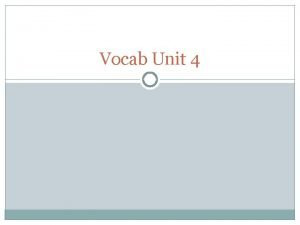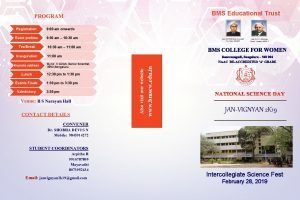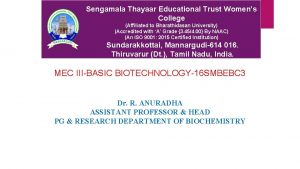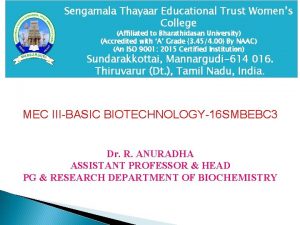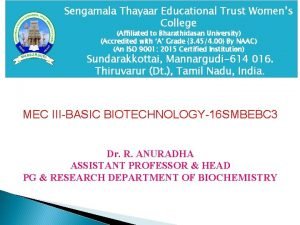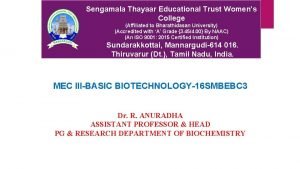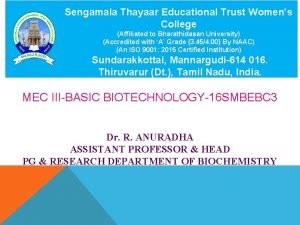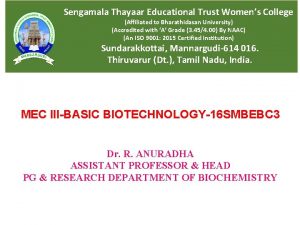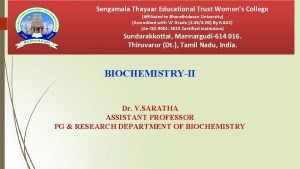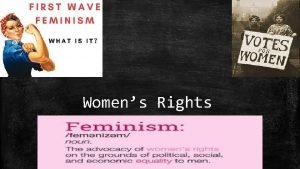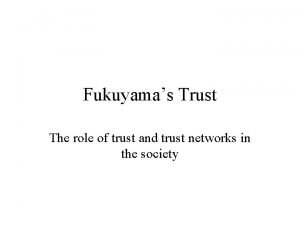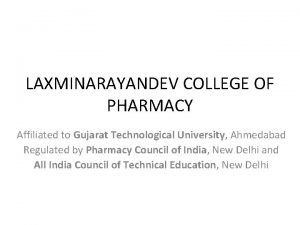Sengamala Thayaar Educational Trust Womens College Affiliated to
























- Slides: 24

Sengamala Thayaar Educational Trust Women’s College (Affiliated to Bharathidasan University) (Accredited with ‘A’ Grade {3. 45/4. 00} By NAAC) (An ISO 9001: 2015 Certified Institution) Sundarakkottai, Mannargudi-614 016. Thiruvarur (Dt. ), Tamil Nadu, India. MEC III-BASIC BIOTECHNOLOGY-16 SMBEBC 3 Dr. R. ANURADHA ASSISTANT PROFESSOR & HEAD PG & RESEARCH DEPARTMENT OF BIOCHEMISTRY


CONTENT v INTRODUCTION. v TRANSGENIC MICE. v METHODS OF TRANSGENIC MICE. 1. RETROVIRAL METHOD. 2. MICROINJECTION METHOD. 3. TRANSFECTION. v APPLICATIONS OF TRANSGENIC MICE. v CONCLUSION.

INTRODUCTION � Genetically manipulated animals having introduced gene in their genetic make up are called TRANSGENIC ANIMALS. They are also known as TRANSGENICS. � Transgenic mice, sheep, cattle, goats, rabbits, poultry, fishes, mosquitoes, etc. , have been developed by using genetic engineering methods.

TRANSGENIC MICE Transgenic mice have been developed since 1980. q They have many applications in modern biology. q There are three methods to construct transgenic mice with novel insert gene. q

METHODS OF TRANSGENIC MICE 1. RETROVIRAL METHOD. 2. MICROINJECTION METHOD. 3. EMBRYONIC STEM CELL METHOD.

RETROVIRAL METHOD � Introduction of foreign DNA into eggs with the help of a retrovirus vector is called RETROVIRAL METHOD. � Small foreign genes. Less than 8 kbp can be transferred to recipient cells through retrovirus vectors. � MURINE LEUKAEMIA VIRUS is the most common retrovirus being used to introduce genes into animals cells.

A mouse line is infected with murine leukaemia virus. RNA of Mu. LV produces ds DNA by reverse transcription. This proviral DNA isolated from the cell line. The foreign gene is linked with a neomycin resistance gene using DNA ligase. The foreign gene is inserted into the proviral DNA using a proper restriction enzyme and DNA ligase. The resulting hybrid DNA is called r. DNA.

The r. DNA is introduced into a mouse cell line by using calcium phosphate mediated transfection. The cell line is then infected with a helper Mu. LV that can produce viral capsid but cannot replicate or with a mutant Mu. LV which has no signal for invivo packaging. RNA of the helper virus produces viral capsid. The r. DNA produces recombinant viral RNA. The latter gets packaged in the viral capsid to form infective recombinant Mu. LV particles. Eggs of mouse are collected and fertilized in vitro to form zygotes. On reaching 8 celled stage, the mouse embryos are infected with the recombinant Mu. LV.

Inside the infected cell the recombinant RNA is reverse transcribed into double stranded. DNA. The DNA integrated with the cell DNA and hence recombinant cells are formed. The mouse embryos are then transferred in to a medium containing neomycin. The embryos having recombinant cells alone survive in the medium and the others die. The living embryos are implanted into surrogate mothers and the mice are fed well. The surrogate mother mice produce transgenic mice siblings with the foreign gene expert.


MICROINJECTION In microinjection method, foreign genes are injected into a fertilized egg by a micropipette. Ø A female mouse is superovulated by injecting Pregnant mare’s serum and human chorionic gonadotropin. The produces about 35 eggs. Ø This female mouse is mated with a male. Fertilized eggs are taken from the oviduct and kept in a balanced salt solution. Ø The eggs are observed under the microscope to pick up eggs having male and female pronuclei, the male pronucleus is larger than the female one. Ø

Ø The foreign gene is microinjected in to the male pronucleus of the eggs with the help of a micropipette. Ø About 25 -40 microinjected eggs are implanted in the uterus of a a foster mother and the female is then mated with a vasectomized male. This mating brings up a pseudopregnant condition for the further development of the eggs in the uterus. Ø The foster mother will give birth to trangenic pups. Ø Transgenic pups can be screened by southern blotting. DNA isolated from small piece of tail is hybridized with known probe to detect the transgenic mice.


EMBRYONIC STEM CELLS In embryonic stem cell method, the desired gene is introduced into inner mass of embryo by transfection. q Mouse embryos at blastocyst stage are collected from pregnant female mouse. q Embryonic stem cells present in the blastocysts are isolated and kept in a balanced salt solution. q The desired foreign gene is linked with a neomycin resistance gene and a sequence for homologous recombination is added on both ends. q The embryonic stem cells and foreign gene construct are mixed together in a tube and the tube is treated with calcium phosphate. The ES cells pick up the DNA from the medium by transfection. q

After transfection, the embryonic stem cells in the tube are transferred to a medium containing neomycin. Recombinant ES cells alone grow in the medium and the others die. q The ES cells forming colonies are picked up from the medium and grown in vitro to get more number of recombinant ES cells. q The recombinant ES cells are microinjected into fresh blastocysts taken from mice. q The microinjected blastocysts are implanted into a foster mother and the mouse is mated with a vasectomised male. q The foster mother, 3 weeks after implantation , delivers transgenic pups. q Transgenic pups are screened by using southern blotting. q


APPLICATIONS Super mouse. Transgenic disease models. Animal pharming. TRANSGENIC MICE Transgenic poultry. Transgenic fishes. Transgenic cattle.

SUPER MOUSE � Ralph Brinster in 1982 developed in fast growing transgenic mouse called SUPER MOUSE. � It was produced by introducing rat growth hormone gene with mouse metalothionein promoter in to the fertilized eggs. TRANSGENIC DISEASE MODELS ü ü Transgenic mice have been used as human disease models for AIDS, Diabetes, Cancer, Alzheimer’s disease, etc. , They are used to understand gene regulation, molecular genetics of disease development immunological responses , etc. ,

ANIMAL PHARMING � Production of pharmaeutical valuable human proteins from the milk of transgenic animals is called ANIMAL PHARMING. � Transgenic mice are developed to have human proteins in their milk. EG: urokinase. TRANSGENIC CATTLE § The methodology for making transgenic cattle is the same as that used to make transgenic mice in microinjection method.

TRANSGENIC POULTRY � Many strains of transgenic chickens have been developed by introducing various foreign genes. � Transgenic methodology has been employed to create : � Transgenic virus resistant chickens. � Transgenic bacteria resistant chickens. � Transgenic chickens with high quality proteins in their meat.

TRANSGENIC FISHES � In fishes fertilization and developmanet are external. � The r. DNA is introduced in to the zygote by microinjection. � Freshly laid eggs are collected from water. � The foreign gene is microinjected into the cytoplasm of the eggs or 4 celled embryos. � The zygotes or embryos are cultured separately in a temperature controlled tank.

CONCLUSION � With proper research and careful use the transgenic animals can go a long way in solving several problems for which science doesn’t have a solution till now.

 Womens college kumbakonam
Womens college kumbakonam Womens college kumbakonam
Womens college kumbakonam Unit 4 vocabulary affiliated
Unit 4 vocabulary affiliated Unit 4 vocabulary affiliated
Unit 4 vocabulary affiliated Affiliated ascertain attainment
Affiliated ascertain attainment Womens shelter edmonton
Womens shelter edmonton Womens ministry activities
Womens ministry activities Ballybeen womens centre
Ballybeen womens centre Womens right
Womens right Womens rights
Womens rights Womens rights
Womens rights Scarborough womens centre
Scarborough womens centre Difference between mens and womens soccer
Difference between mens and womens soccer Womens history month door
Womens history month door Picture of female uterus
Picture of female uterus Late night womens hour
Late night womens hour Womens lacrosse helmets
Womens lacrosse helmets Womens right
Womens right Womens community shelters
Womens community shelters Aylesbury womens aid
Aylesbury womens aid Bristol womens voice
Bristol womens voice Bms educational trust
Bms educational trust Charitable work
Charitable work Early college high school at midland college
Early college high school at midland college Wake tech admissions
Wake tech admissions


